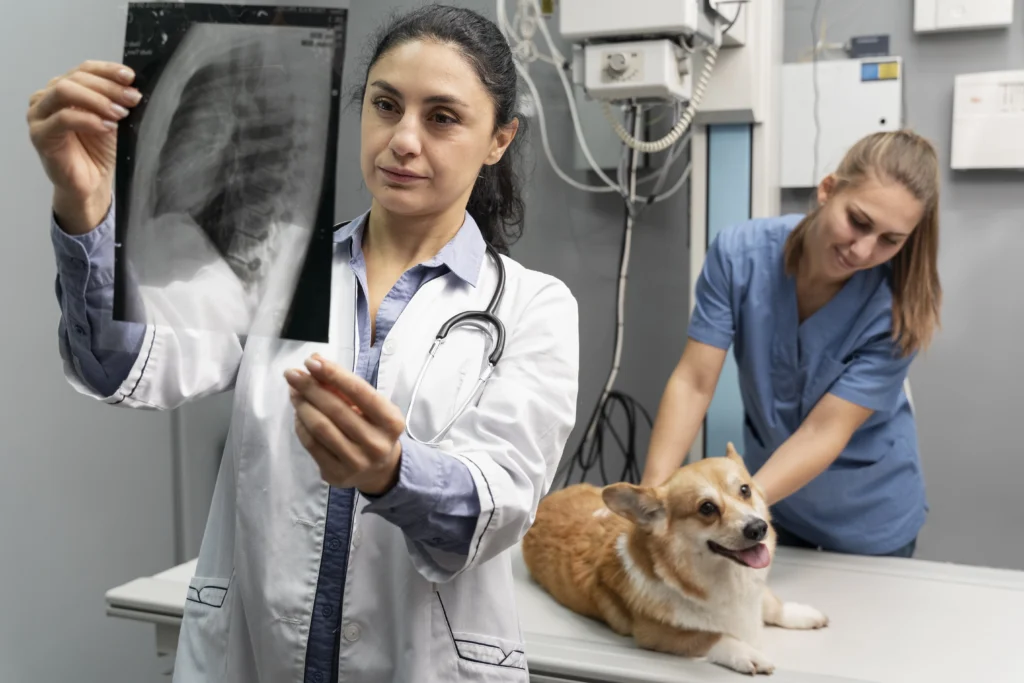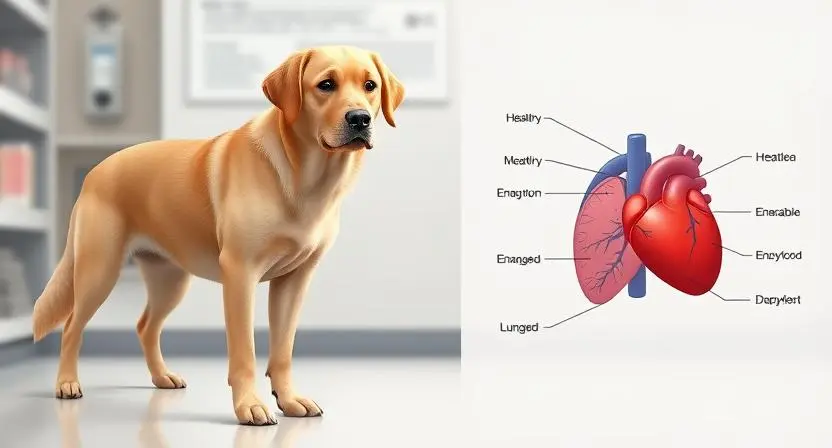Enlarged Heart in Dogs: The Ultimate Guide to Successfully Managing This Serious Condition
Table of Contents
Receiving a diagnosis of an enlarged heart in dogs can be frightening and overwhelming. When veterinarians detect an enlarged heart in dogs, pet parents are suddenly faced with medical terminology, treatment options, and difficult questions about their furry companion’s future. This comprehensive guide about enlarged heart in dogs is here to walk you through every step of understanding this condition, from initial symptoms to long-term management strategies.
Key Takeaways
Before diving deep, here are the essential facts every dog owner should know about enlarged heart in dogs:
• An enlarged heart is a symptom, not a disease itself – it indicates an underlying cardiac condition • Common causes include Dilated Cardiomyopathy (DCM) and Chronic Valve Disease • Key symptoms are persistent coughing, fatigue, and breathing difficulty • Diagnosis requires specialized tests like X-rays and echocardiograms • While often not curable, it is manageable with proper medication and monitoring • Early detection significantly improves quality of life and prognosis
What Is an Enlarged Heart (Cardiomegaly)? A Simple Analogy
When veterinarians talk about an enlarged heart in dogs, they’re describing a symptom called cardiomegaly – not a standalone disease. Understanding enlarged heart in dogs requires recognizing that this condition affects your dog’s cardiovascular system significantly. Think of your dog’s heart muscle like an overstretched rubber band. When a rubber band is stretched beyond its normal capacity for too long, it becomes weak and loses its ability to snap back efficiently. Similarly, when dealing with enlarged heart in dogs, the heart becomes weak and inefficient at pumping blood throughout the body.
This enlargement occurs when the heart muscle is forced to work harder than normal due to underlying conditions. The heart compensates by growing larger, but this adaptation eventually becomes counterproductive, leading to decreased cardiac function and the symptoms we associate with heart disease.
Understanding the Heart’s Structure:
- Left ventricle: The main pumping chamber that sends blood to the body
- Right ventricle: Pumps blood to the lungs
- Atria: Upper chambers that receive blood returning to the heart
- Heart valves: One-way doors that prevent blood from flowing backward
The Two Main Causes: DCM vs. Other Conditions
Understanding the root cause of your dog’s enlarged heart is crucial for proper treatment. When dealing with enlarged heart in dogs, the two primary categories are distinctly different in their mechanisms and treatment approaches.
Dilated Cardiomyopathy (DCM) – The Muscle Disease
DCM is a disease of the heart muscle itself, where the muscle fibers become weak and stretched. This condition primarily affects the heart’s ability to contract forcefully, leading to poor blood circulation.
Chronic Valvular Disease – The Valve Problem
This condition involves the deterioration of heart valves, particularly common in smaller breeds. When valves don’t close properly, blood leaks backward, forcing the heart to work harder.
| Comparison Factor | Dilated Cardiomyopathy (DCM) | Chronic Valvular Disease |
|---|---|---|
| Typical Breeds | Large breeds (Dobermans, Great Danes, Boxers) | Small to medium breeds (Cavaliers, Chihuahuas) |
| Part of Heart Affected | Heart muscle (primarily left ventricle) | Heart valves (especially mitral valve) |
| Primary Cause | Genetic predisposition, possibly diet-related | Age-related valve degeneration |
| Onset | Often sudden in middle-aged dogs | Gradual progression over years |
Symptoms: From Subtle Signs to Emergency Warnings
Dog heart enlargement diagnosis relies heavily on recognizing symptoms, which can range from barely noticeable to life-threatening. Early detection of enlarged heart in dogs helps ensure timely veterinary intervention and better outcomes for your pet.
Early/Subtle Signs
These initial symptoms are often dismissed as normal aging but warrant veterinary attention:
- Mild exercise intolerance (getting tired more quickly during walks)
- Occasional dry, hacking cough (especially at night or early morning)
- Slightly faster breathing rate at rest
- Restlessness during sleep or difficulty finding comfortable sleeping positions
Advanced/Obvious Signs
As the condition progresses, symptoms become more apparent:
- Persistent “cardiac cough” that sounds like honking
- Noticeable decrease in appetite and energy levels
- Swollen belly (ascites) due to fluid accumulation
- Rapid weight loss despite normal or decreased appetite
- Episodes of weakness or fainting (syncope)
🚨 EMERGENCY SIGNS – When to See a Vet Immediately
Call your emergency vet if you observe:
- Struggling to breathe or open-mouth breathing
- Blue-tinged gums or tongue (cyanosis)
- Collapse or inability to stand
- Constant, uncontrollable coughing
- Complete loss of appetite for more than 24 hours
Common Causes and High-Risk Breeds
Certain dog breeds have genetic predispositions to developing enlarged heart in dogs, making regular cardiac screening essential for these populations. Recognizing breed-specific risks for enlarged heart in dogs helps owners stay proactive about their pet’s cardiac health.
High-Risk Breeds for DCM:
- Doberman Pinschers: Up to 60% may develop DCM
- Great Danes: Often develops in middle age
- Boxers: May have arrhythmogenic form
- Irish Wolfhounds: Giant breed predisposition
- Cocker Spaniels: American variety particularly susceptible
The Controversy: Diet, Taurine, and DCM
Recent FDA investigations have highlighted a potential link between certain grain-free diets and DCM development. The research suggests that diets high in legumes (peas, lentils) and low in traditional grains might contribute to taurine deficiency, particularly affecting breeds not typically predisposed to DCM.
Key Points from Current Research:
- Over 500 cases reported to FDA between 2014-2019
- Many affected dogs were eating boutique, exotic ingredient, or grain-free (BEG) diets
- Golden Retrievers showed unexpected DCM prevalence
- Some dogs improved when diet was changed and taurine supplemented
Always consult with your veterinarian before making dietary changes, especially if your dog has been diagnosed with heart disease.
The Diagnostic Process: What to Expect at the Vet
Understanding the diagnostic process for enlarged heart in dogs can help reduce anxiety and ensure you’re prepared for your veterinary visit. Dog heart disease treatment begins with accurate diagnosis through multiple testing methods.
Physical Examination & Stethoscope Assessment
Your veterinarian will listen carefully to your dog’s heart, checking for:
- Heart murmurs (abnormal whooshing sounds)
- Irregular rhythms (arrhythmias)
- Increased heart rate
- Abnormal lung sounds indicating fluid accumulation
Chest X-rays (Radiographs)
X-rays provide a clear picture of:
- Heart size and shape compared to normal proportions
- Fluid accumulation in lungs (pulmonary edema)
- Blood vessel changes
- Overall chest cavity assessment
Echocardiogram – The Gold Standard
This specialized ultrasound is crucial for definitive diagnosis, showing:
- Real-time heart function and blood flow
- Chamber sizes and wall thickness
- Valve function and any leakage
- Contractility measurements (ejection fraction)
ECG/EKG – Electrical Activity Assessment
This test monitors the heart’s electrical rhythm, identifying:
- Arrhythmias or irregular heartbeats
- Electrical conduction problems
- Chamber enlargement patterns
Treatment and Management: A Multi-Faceted Approach
Modern dog heart disease treatment focuses on managing symptoms, slowing progression, and maintaining quality of life through multiple therapeutic approaches.
Medications – The Foundation of Treatment
Pimobendan (Vetmedin)
- Improves heart muscle contractility
- Opens blood vessels to reduce workload
- Often called a “life-extending” medication
Diuretics (Furosemide/Lasix)
- Removes excess fluid from lungs and body
- Reduces breathing difficulty
- Requires careful monitoring of kidney function
ACE Inhibitors (Enalapril, Benazepril)
- Reduces blood pressure and heart workload
- Slows disease progression
- Protects kidney function
Beta Blockers
- Controls heart rate and rhythm
- Particularly useful in certain arrhythmias
- Must be introduced gradually
⚠️ Important: Never adjust medication dosages without veterinary guidance. Cardiac medications require precise dosing and regular monitoring.
Diet & Nutrition Management
Prescription Cardiac Diets:
- Reduced sodium content (typically <0.3% dry matter)
- Balanced protein levels to maintain muscle mass
- Enhanced with beneficial nutrients like omega-3 fatty acids
Beneficial Supplements (Vet-Approved):
- Taurine: Essential amino acid for heart function
- L-carnitine: Supports cellular energy production
- Omega-3 fatty acids: Anti-inflammatory properties
- Coenzyme Q10: Antioxidant supporting cellular energy
Home Monitoring Checklist
Successful management requires consistent home monitoring:
Daily Observations:
- [ ] Resting respiratory rate (normal: 15-30 breaths per minute)
- [ ] Appetite and water consumption
- [ ] Energy levels and exercise tolerance
- [ ] Cough frequency and character
Weekly Assessments:
- [ ] Body weight (sudden changes indicate fluid retention)
- [ ] Gum color (should be pink, not pale or blue)
- [ ] Sleeping patterns and comfort
Prognosis and Quality of Life
While an enlarged heart diagnosis can feel overwhelming, understanding realistic expectations helps families make informed decisions about their dog’s care.
Factors Affecting Prognosis:
- Stage of disease at diagnosis
- Underlying cause (DCM vs. valve disease)
- Response to initial treatment
- Owner compliance with medication and monitoring
What “Good Quality of Life” Means:
- Comfortable breathing at rest
- Interest in food and surroundings
- Ability to enjoy gentle exercise
- Peaceful sleep without excessive coughing
- Positive interaction with family members
Many dogs with properly managed heart disease can enjoy months to years of good quality life. The key is working closely with your veterinary team to adjust treatments as the condition progresses.
The Cost of Care: A Practical Financial Guide
Understanding the financial commitment helps families plan for their dog’s cardiac care needs when managing enlarged heart in dogs.
Initial Diagnosis Costs:
- Veterinary examination: $75-150
- Chest X-rays: $150-300
- Echocardiogram: $300-600
- ECG: $100-200
- Blood work: $150-250
- Total initial workup: $775-1,500

Monthly Medication Costs:
- Small dogs (under 25 lbs): $50-100/month
- Medium dogs (25-60 lbs): $100-200/month
- Large dogs (over 60 lbs): $200-400/month
Follow-up Care:
- Recheck examinations: $100-200 every 3-6 months
- Monitoring bloodwork: $100-150 quarterly
- Follow-up echocardiograms: $300-500 annually
Many pet insurance policies cover cardiac conditions diagnosed after the policy effective date. Consider insurance early in your dog’s life for maximum coverage.
Comprehensive FAQ Section
Can an enlarged heart in dogs be reversed?
Unfortunately, true reversal of enlarged heart in dogs is rare. However, early intervention can sometimes reduce heart size if the underlying cause is addressed (such as dietary factors in some DCM cases). Most treatments for enlarged heart in dogs focus on slowing progression and managing symptoms rather than reversing existing damage.
How long can a dog live with an enlarged heart?
Survival times for dogs with enlarged heart in dogs vary significantly based on several factors. Dogs with early-stage enlarged heart in dogs and good treatment response may live 1-3 years or more with good quality of life. Advanced cases may have shorter timeframes, but palliative care can still provide comfort and meaningful time together.
Is an enlarged heart painful for a dog?
The enlarged heart itself typically isn’t painful, but associated symptoms can cause discomfort. Difficulty breathing, fluid accumulation, and fatigue can reduce comfort levels. Proper medication management usually alleviates these uncomfortable symptoms significantly.
What is congestive heart failure (CHF) and how is it related?
CHF occurs when the enlarged heart can no longer pump blood effectively, leading to fluid backup in the lungs or abdomen. It represents an advanced stage of heart disease where the compensatory mechanisms have failed. Many dogs with enlarged hearts will eventually develop CHF, but proper treatment can delay this progression.
What should I feed a dog with an enlarged heart?
Feed a veterinary-prescribed cardiac diet low in sodium (less than 0.3% dry matter). Avoid high-sodium treats like deli meats, cheese, and commercial jerky. Maintain consistent meal times and monitor for any dietary changes that might affect medication absorption.
Moving Forward with Confidence
An enlarged heart diagnosis doesn’t mean the end of your dog’s happy life – it means the beginning of a new chapter focused on management and maintaining quality time together. With proper veterinary care, appropriate medications, and dedicated home monitoring, many dogs continue to enjoy meaningful, comfortable lives.
Remember that you’re not alone in this journey. Your veterinary team is your partner in providing the best possible care for your beloved companion. Stay informed, ask questions, and trust in the power of modern veterinary medicine to help manage this challenging condition.


